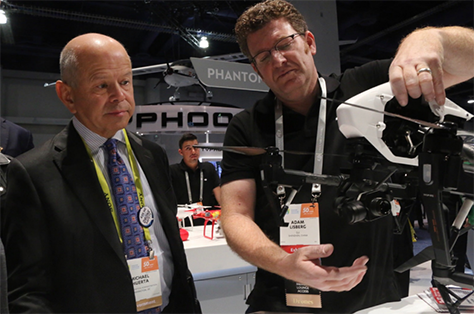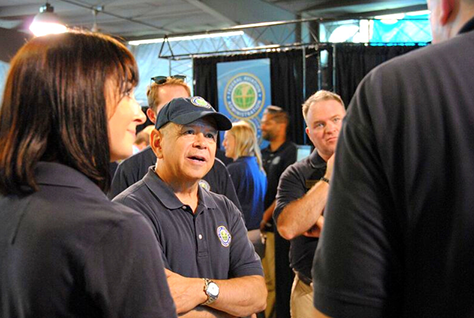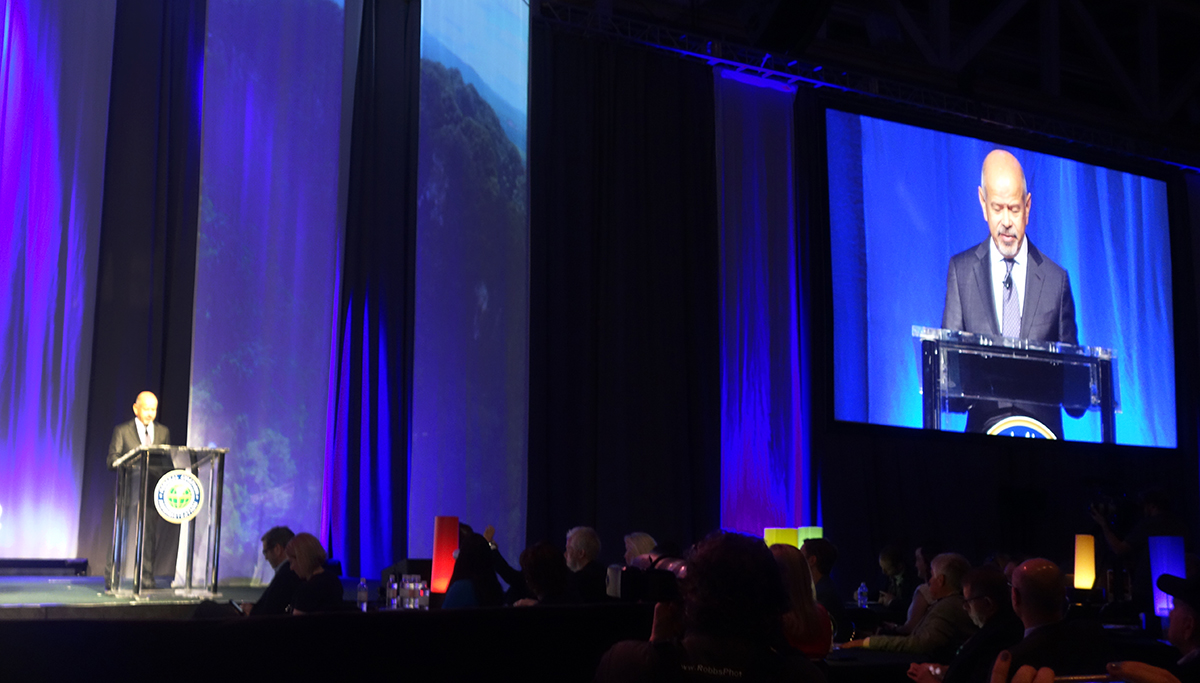
Michael Huerta during his tenure as Administrator of the Federal Aviation Administration (FAA). Photo courtesy of the FAA.
On January 6
th, Michael Huerta’s five-year term as FAA Administrator
came to an end. Several important milestones for the commercial drone industry occurred during his tenure, including the FAA Modernization and Reform Act of 2012, the establishment of the Drone Advisory Committee and the rollout of Part 107. Despite presiding over one of the most challenging and controversial times that the FAA has ever encountered, the agency nonetheless experienced an unprecedented safety record during his term, with no fatalities on U.S.-regulated passenger carriers.
Safety was and is the top priority for the FAA, but many in the drone industry believed he took that priority to the extreme. His critics were neither quiet nor shy, but the past few years saw some of that criticism
begin to diminish. Numerous individual and organizations have recognized his efforts to
move UAS policymaking forward, even as practical and policy challenges associated with leveraging drones for commercial purposes remain.
The fact that he wasn’t able to completely please everyone illustrates how and why he was such a successful Administrator though. His efforts to work with drone technology advocates without jeopardizing the safety of the skies have established a legacy for commercial drone regulation that will serve the industry far longer than the specific policies he helped to enable.
The “Accidental Administrator”On January 26, 2010, Michael Huerta
appeared before Congress to be confirmed as the Deputy Administrator of the FAA after being nominated to the position by President Obama. His actual confirmation was held up by a political squabble, but on June 23, 2010, he became Deputy Administrator serving under FAA Administrator Randy Babbitt. Huerta’s focus on
NextGen technology and the fact that he didn’t have experience as a pilot were not major considerations at the time, but both would soon become major talking points.
Just about a year and half after being confirmed, Huerta became Acting Administrator when Babbitt resigned the position in December of 2011. It’s the reason Huerta has sometimes referred to himself as the “
Accidental Administrator”, but with the
FAA Modernization and Reform Act being announced less than two months later, there was little time to dwell on his status or even his non-pilot experience. Specifically tasked with providing a framework for integrating new technology like drones safely into the national airspace (NAS), Huerta found himself at the forefront of discussions about how terms like “aircraft” and even “airspace” needed to be interpreted, or reinterpreted. These were conversations that had begun under Administrator Babbitt, but Huerta’s role was pivotal nonetheless.

Photo courtesy of the FAA.
“Even though Administrator Huerta didn't initiate discussions about how these terms were changing, he certainly executed them,” said Douglas Spotted Eagle, whose involvement with commercial UAS is an extension of his decades of experience related to aerial robotics. “In some ways that execution is the harder challenge because talking about these changes is one thing, but actually getting them into the greater public, and redefining them in the eyes of the public meant having a completely different conversation. These concepts were being discussed before his tenure, but he truly brought them into in the greater world.”
This process saw the FAA get feedback from the manned aviation community, commercial drone industry advocates, hobbyists and plenty of other stakeholders. All of them had unique issues and concerns with how the FAA was moving forward, but the Section 333 Exemption and creation of the
Pathfinder program demonstrated that Huerta wasn’t going to let any one corner of the industry dominate the discussion. There was always a balance that he needed to strike between allowing the technology to change things too fast and keeping the regulatory environment impractically static. His experience as Deputy Administrator may have directly served his ability to look for and find that balance.
In his role as Deputy Administrator, Huerta’s chief responsibility was with NextGen, which is essentially the modernization of the air traffic control system. It’s a program that goes back to 2003, but because UAVs were increasingly considered a component within NextGen, Huerta was uniquely prepared to address UAV integration when he became the full Administrator. However, it also meant dealing with issues that have nothing to do with actual drone technology.
“The problem the FAA encountered with unmanned aircraft is that they had to deal with a new disruptive technology within the constraints of a regulatory regime that was based on manned aircraft,” said Bill Carey, author of
Enter the Drones. “They were forced to apply the standards for building and flying manned aircraft to things like quadcopters, and of course they often didn’t carry over all that well. There was always that balance that had to be struck, and Administrator Huerta can take responsibility for the successful accommodations that were made.”
That balance is critical, because above all else, safety is paramount for the FAA. This reality could have seen it become Huerta’s only concern, but his ability to prioritize safety while still taking into account other perspectives is what will define his tenure and legacy as FAA Administrator.

Photo courtesy of the FAA.
In his
book that showcases the incredible history of the drone industry, Bill Carey refers to Huerta as “a practiced public servant who appeared unflappable during interrogations by various congressional panels.” It’s an especially appropriate description, partly because the word “unflappable” often comes up when anyone describes Huerta’s demeanor and approach.
As someone that was being bombarded by feedback from every angle about what could or should be happening in the airspace, Huerta’s resolve allowed him to pursue policies that were not driven by whoever was yelling the loudest. The boos he sometimes got at industry events affected him the same as the cheers. As it turned out though, his unflappable nature ended up serving an even greater purpose.
“He was a clear promoter of industry and regulator cooperation,” said Colin Snow, CEO of Skylogic Research, whose firm created arguably the
most reliable drone market sector report available. “He understood and actively supported coming up with solutions for the integration of unmanned aircraft systems into the NAS. I really appreciated his perspective that solutions shouldn't be mandated by the FAA, and that they should have performance-based requirements, not hardware or software-based requirements. He wanted the FAA to prescribe the performance requirements, but not the actual solutions.”
The fact that these requirements were about more than just safety and could include commercial necessities is essential, and wasn’t something everyone agreed with. He was often pushed to take a different approach, but he never wavered from his focus on being inclusive, and operating his team as a collaborative effort. That collaborative effort is part of the reason we saw dedicated efforts to redefine what it meant to legally and safely operate a drone.
Nonetheless, criticisms that Huerta and the FAA weren’t being collaborative enough were often made, especially when it came to the speed at which regulators were moving. Efforts to
streamline the Section 333 Exemption process and the rollout of
Part 107 proved that he never did stop listening, acting and changing in an especially meaningful way though.
“One of the primary roles of the administration is to not create policy by fiat, but to take in all the different views and do your best to balance them and hear what everyone has to say,” Douglas told Commercial UAV News. “That means creating committees that can take all these things into consideration, and I think that's where Michael was the winner. He's very nimble and able to jump from stone to stone without falling into the pit. He was able to create a variety of avenues for these conversations to occur, and truly does listen in a meaningful way. A lot of people listen to respond, but I think Michael Huerta listens to understand.”
That concept of listening to understand proved to be crucial for both Huerta and the commercial drone industry as a whole. Ultimately, it’s the reason that none of the significant milestones associated with his tenure will end up being his most meaningful achievement.

Photo courtesy of the FAA.
We’ve often talked about how
incredibly fast drone technology moves, and these developments will continue to create issues on a regulatory level. Despite the optimism and opportunity associated with Part 107, many are focused on elements like flying beyond visual line of sight (BVLOS) and operating at night, which are not covered under Part 107. The speed of bureaucracy remains an issue for many, although it’s certainly
not an issue specific to drone technology.
Acting FAA Administrator Dan Elwell will be focused on establishing policies that will address some of these specific issues, which in practice will be different from the ones that Michael Huerta sorted through. However, the principles are for the most part the same, which is why the precedents established by Huerta will significant in an unexpected way.
“It really is an evolution,” said Snow. “Administrator Huerta established some important precedents in regards to airspace challenges, but what comes next for the industry is really the next iteration of those challenges. That means the collaboration between industry and regulators needs to evolve as well, but we’ve seen what kind of advances are possible. You often hear organizations talk about moving from analogue to digital, but Huerta and his team helped move the FAA from paper to digital. Further automation is going to define expectations across the board, but all of it is still just about taking the next step. The approach around taking that next step is really the precedent he helped establish.”
That next step will undoubtedly be about making operations like flying over people simpler than applying for a waiver under Part 107, and many will be watching to see exactly how that process unfolds. Critically though, it’s a process that is set to happen from performance-based requirement in tandem with industry stakeholders, all of which will be a direct result of the path Michael Huerta laid out.
The next Administrator of the FAA will undoubtedly be dealing with issues that could be even bigger than the ones Huerta faced, especially with drone registry being ruled illegal and now reinstated. How can or should the FAA keep track of the millions of drones being flown by hobbyists? What role will state and local regulations play for operators? These are just some of the issues that are continuing to evolve and define the landscape.
“The cyclical, politically-based funding issues that have always challenged the FAA will continue,” said Carey. “The next Administrator is also going to have to deal with the emergence of counter UAS systems and where and how should those be applied. There’s also the continuing development of the UTM system and how the FAA will become more involved with the work NASA is doing for it. And of course, somehow, someday, allowing BVLOS.”
The future Administrator will need to sort through challenges that are both small and large, and they’ll undoubtedly be relying on policy precedents established by Michael Huerta. These policies will become less and less important as the issues continue to evolve, but Huerta’s effort to include people on all sides to figure out how challenges should be sorted out will resonate far longer.
More than anything else, that approach related to collaboration and inclusion will serve as his legacy and continue to effectively support the commercial drone industry.










Comments